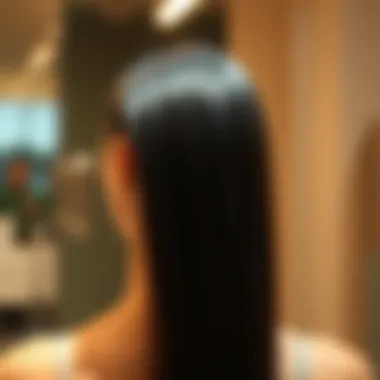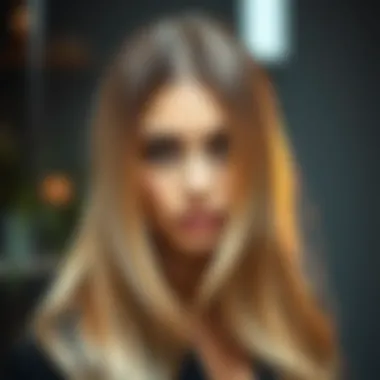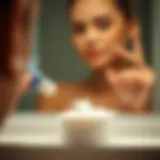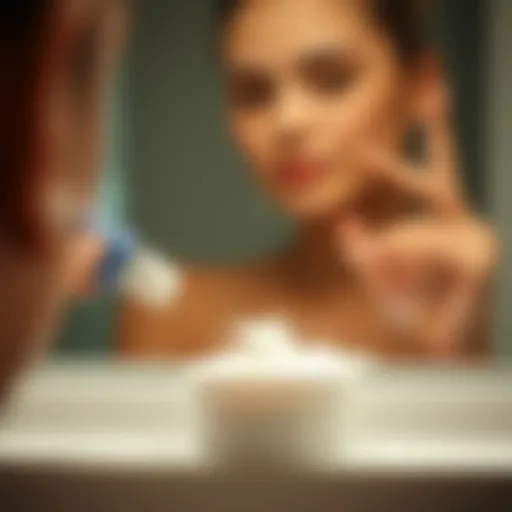Essential Care for Keratin-Treated Hair


Intro
Caring for keratin-treated hair can be a bit of a tightrope walk. On one hand, there's the allure of smooth, shiny locks, while on the other, there's the constant upkeep required to keep them looking their absolute best. Keratin treatments have surged in popularity, offering a solution for frizzy and unruly hair. However, it doesn't stop with just the treatment; understanding the nuances of maintaining that silky finish is essential.
In this guide, we will strip away the excess noise and focus on what truly matters. From understanding the products that pair well with keratin treatments to the lifestyle changes that can make a significant impact, this article aims to provide you with a comprehensive understanding of how to care for your hair post-treatment. By the end of our journey, you’ll have the tools to ensure that your keratin-treated tresses retain their vibrancy and luxury for as long as possible.
Tips and How-Tos
Choosing the Right Products
Selecting the right products is key. Not all shampoos and conditioners are created equal, especially when it comes to keratin-treated hair. Here’s what to look for:
- Sulfate-Free Shampoos: These gentle cleansers won't strip away the keratin. Brands like Kevin Murphy and Bumble and Bumble offer good choices.
- Moisturizing Conditioners: Hair can still dry out even after treatment. Take a peek at Moroccanoil Moisture Repair Conditioner for a deep hydration boost.
- Leave-In Treatments: Products like It's a 10 Haircare Miracle Leave-In can add extra moisture and protection without weighing hair down.
When selecting keratin-friendly products, think of it as curating your hair's travel kit to a tropical destination—only the essentials that protect and enhance.
Haircare and Styling Basics
Taking care of keratin-treated hair doesn't end with product selection. Follow these simple steps for effective haircare:
- Avoid washing hair for a few days post-treatment. This allows the keratin to fully bond with your hair strands.
- Limit heat styling. Too much heat can damage the treatment. If you must use heat tools, ensure they have a heat protectant.
- Be cautious with swimming. Chlorine or saltwater can wreak havoc on your treatment. Always wear a swimming cap or rinse your hair thoroughly post-swim.
- Get regular trims. This prevents split ends and keeps your hair looking healthy and vibrant.
Conclusion: Prioritizing the right products and sticking to essential care routines can have a long-lasting impact on your keratin-treated hair. By taking these steps, you will help ensure your locks not only look good but feel good too.
Sustainable Practices
Eco-Friendly Hair Care Options
It’s not just about how our hair looks, but also about how our choices affect the environment. When researching hair care products, consider brands that prioritize sustainability. For example:
- Aveda focuses on using natural ingredients and sustainable practices in its products.
- Rahua, with its plant-derived ingredients, boasts an eco-friendly formula without sacrificing results.
- Ethique, known for its solid shampoo bars, also helps minimize plastic use.
Tips for Sustainable Grooming
Maintaining beauty routines sustainably can be done with a few simple habits:
- Use Reusable Hair Accessories: Avoid single-use hair ties and clips.
- Choose Biodegradable Products: Items that break down naturally can lessen environmental impact.
- Recycle packaging: Many brands provide options for returning used containers for recycling.
Celebrating Diversity in Beauty
Inclusive Beauty Brands
In recent times, beauty inclusivity has taken center stage. Brands like Fenty Beauty and Kylie Cosmetics have expanded the narrative on what beauty means by providing products for all shades and types of hair. This shift allows people from various backgrounds to find products that suit their unique needs.
Cultural Influences on Hair Care
Hair care practices vary widely from culture to culture. Traditional methods, such as the use of coconut oil in South Asia or argan oil in Morocco, showcase how diverse our approaches to hair care can be. Embracing these practices can enrich one's hair care routine, marrying tradition with modern techniques for optimal results.
By paying attention to the products we choose and the practices we adopt, we not only take care of our hair but also support the broader narratives within the beauty industry. Connecting hair care with sustainability and diversity fosters a richer understanding of beauty itself.
Foreword to Keratin Treatments
Caring for keratin-treated hair is a topic that strikes a chord with many individuals, particularly those who seek a sleek, polished look without much fuss. Understanding keratin treatments forms the backbone of any effective hair care routine for those who indulge in this popular beauty regimen.
Keratin, a natural protein that exists in hair, skin, and nails, plays an essential role in maintaining hair’s strength and structure. But when external factors like heat styling, environmental exposure, and chemicals take their toll, keratin treatments present a way to revive and restore hair's integrity. This section will dissect the fundamentals of keratin treatments, explaining why they are so favorable, along with the myriad benefits they offer.
Definition and Purpose
A keratin treatment is a cosmetic procedure designed to smooth and relax the natural texture of hair. The process generally involves applying a keratin-infused solution, which is then sealed into the hair using heat. This infused keratin acts as a protective layer, bridging gaps in the hair cuticle, and effectively creating a sleek and manageable appearance. In simpler terms, keratin treatments aim to mend damaged hair and offer a remedy for frizz, making it more manageable for styling.
For many, the purpose of getting a keratin treatment transcends aesthetics; it's about nurturing hair back to health and simplifying daily hair routines. With less time spent on styling, a keratin treatment can save a significant amount of time while promoting the well-being of the hair overall.
Benefits of Keratin Treatments
The appeal of keratin treatments lies in their ability to deliver multiple benefits, often unmatched by other hair care methods. Here are some of the standout advantages:
- Frizz Reduction: Keratin treatments are known for their ability to diminish frizz, making unruly locks easier to tame.
- Sleek, Shiny Finish: Treated hair often exhibits a glossy shine, enhancing the appearance and overall health of the hair.
- Time-Saving: With reduced drying and styling times, many individuals experience significant efficiency gains in their daily routines.
- Long-Lasting Results: A single treatment can keep hair looking fresh for weeks, making keratin treatments appealing for those looking for longevity in their hair care investments.
- Enhanced Manageability: Post-treatment, hair becomes easier to style and handle, catering to even the busiest lifestyles.
"Keratin treatments have transformed my hair care routine. The results are simply astounding — I can’t imagine going back to the way it was!"


Ultimately, the significance of keratin treatments fabricates not only an opportunity for aesthetic enhancement but also symbolizes a commitment to the ongoing health of one’s hair. Investing time and resources into understanding the nature and purpose of these treatments is crucial for anyone seeking to maintain their luscious locks for the long haul.
Initial Care After Treatment
Initial care following a keratin treatment is crucial for the longevity and health of your hair. This period can often set the stage for how well the treatment holds up and how your hair behaves post-application. Understanding what to do—and what to avoid—during this phase is vital. Keratin is a protein that smooths and glosses hair, but it also requires some tender loving care right out of the gate. If you bobble things up at this stage, it's possible to wind up with lackluster results.
Waiting Period Recommendations
After getting your keratin treatment, most stylists recommend a waiting period before washing or exposing your hair to moisture. Typically, this waiting time spans from 48 to 72 hours, depending on the specific formulation used. This period is akin to allowing a cake to firm up—if you cut it too soon, you may ruin its structure.
Leaving your hair untouched during this timeline helps lock in the keratin, providing optimal results. Some people treat these two to three days like a vigil, suspending their normal grooming habits. It's often easy to forget about how important this is, but resist the urge to dampen those lovely locks. If you do end up washing your hair too early, the moisture can interfere with the treatment, leading to an uneven texture or premature fading.
To make this waiting period easier:
- Plan Accordingly: If you’ve got a big event or a special occasion coming up, try scheduling the treatment in advance.
- Use a Silk or Satin Pillowcase: This reduces friction while you sleep, helping maintain that smooth feel.
- Avoid Hairstyling Products: Steer clear of hair accessories or pins that could create creases or bends during this delicate period.
Avoiding Water and Moisture
One of the most critical instructions to follow right after a keratin treatment is to avoid water and moisture. Think of this as a strict no-swimming sign for your hair. The safest route is to keep it under wraps, and I mean that quite literally; try wearing a shower cap while bathing or stay out of the rain for these first few days.
Water can dilute the keratin complex and, in doing so, diminish the results you seek. It’s like washing away all your hard work, which is definitely something you want to avoid. Sweat can also be an enemy; any exercise routine should be temporarily set aside until the waiting period concludes. Once that’s over, you can ease back into your normal activities, but be conscious of your hair's needs.
Here are a few additional guidelines to help keep your hair safe from moisture:
- Avoid Steam Rooms and Saunas: These beneficial health spots may be relaxing, but they’re not good for your hair’s fresh treatment.
- Be Cautious in Humid Weather: High humidity can cause your hair to absorb moisture from the air, which may impact the treatment’s effects. If you can, plan your outing for less muggy days.
- Embrace Head Coverings: Whether it’s a cute hat or a scarf, these can protect your hair from unexpected splashes of water or moisture.
Your consideration of these early-care protocols can significantly influence how long that keratin treatment will last. A little effort now goes a long way in preserving the silky strands you’ve just acquired. Think of this like investing stocks; the longer you keep your money in, the better the return. Remember, patience is not just a virtue—it’s essential for your hair!
"Hormones of the hair are patience and care; give them time to settle down, and your patience will pay off."
For additional insights into post-treatment care, check out resources like Britannica or Wikipedia.
By following these initial care tips, you are setting the groundwork for a successful keratin experience—one that keeps your hair vibrant and manageable for as long as possible.
Choosing the Right Hair Care Products
Choosing the right hair care products is a crucial step in preserving the beauty and integrity of keratin-treated hair. By selecting products designed specifically for your hair type, you can significantly improve the treatment's longevity and efficacy. Taking care of keratin-treated hair requires more than just a basic shampoo and conditioner; it involves a thoughtful selection of specialized products that work in harmony with your hair's unique needs.
By using the right products, you ensure that they maintain the keratin's protective effects while providing nourishment and moisture balance. This way, you minimize exposure to harsh chemicals that precipitate fading or damage. Ultimately, the right product choices support your hair care routine, enabling consistent results and healthier hair over time.
Sulfate-Free Shampoos
When it comes to keratin-treated hair, sulfate-free shampoos are often recommended. Sulfates, which are commonly found in mainstream shampoos, can strip away essential oils and moisture from the hair, leaving it dry and brittle. This is particularly troublesome for keratin-treated hair, which relies on moisture retention for maintaining its smooth, glossy appearance.
Opting for sulfate-free alternatives ensures that you kindly cleanse your scalp and hair without erasing the benefits of keratin treatment. Ingredients found in these shampoos often include natural extracts and essential oils that not only cleanse but also enrich the hair. When browsing options, keep an eye out for products infused with nourishing elements, such as coconut oil or argan oil. They help to soothe and hydrate without the risk of harsh lather that can compromise your treatment.
Conditioners Specifically for Treated Hair
A specialized conditioner tailored for keratin-treated hair plays an instrumental role in maintaining the treatment's benefits. Regular conditioners may not offer the specific nutrients necessary for keratin care. Conditioners made for treated hair usually contain hydrolyzed keratin. This ingredient fortifies the hair structure, replenishing lost proteins that can occur during the treatment process.
Incorporating a high-quality conditioner into your routine ensures that your hair remains supple and manageable. As you apply conditioner, distribute it evenly from mid-lengths to the ends, letting it sit for a few minutes to allow your hair to absorb the moisture and nutrients. For best results, look for deep conditioning masks to use on a weekly basis so that you can give your hair the extra love it deserves.
Heat Protectants
Heat protectants are a non-negotiable in the care regimen for keratin-treated hair. Whenever you apply heat—be it from a blow dryer, curling iron, or straightener—your hair faces potential damage. Keratin-treated hair is already more vulnerable, thus it requires additional protection against this thermal stress.
Using a heat protectant before styling creates a barrier that shields the hair from high temperatures. It's advised to choose a product that can shield your hair from heat levels appropriate to your styling tools, generally up to 450°F. Look for those that contain silicones and natural oils, as they can help in locking moisture and adding a protective shine. Finding a heat protectant should be part of your styling routine, as it plays an essential role in keeping your keratin treatment looking fresh and vibrant.
"Selecting the right hair care products is a game changer in maintaining the benefits of keratin treatments. Each product works together to reinforce the advantages and ensure consistent hair health."
In summary, equipping yourself with sulfate-free shampoos, specialized conditioners, and effective heat protectants is fundamental in nurturing keratin-treated hair. These meticulously chosen products not only extend the vitality of your treatment but also enhance the overall health and appeal of your hair.
Washing Techniques for Keratin-Treated Hair
Washing keratin-treated hair requires a level of care that goes beyond regular hair care routines. The nature of keratin treatments means that maintaining a balance between cleanliness and preserving the integrity of the treatment is crucial. Hair texture can be altered by these treatments, and therefore, selecting appropriate washing techniques is important for both longevity and vibrancy. Well-executed washing techniques play a significant role in ensuring that the keratin bonds remain intact, which directly influences the overall appearance and feel of the hair.
Optimal Washing Frequency
The question of how often to wash keratin-treated hair is a common one, and it doesn’t have a one-size-fits-all answer. Generally speaking, the recommendation for most individuals is to limit washing to about two to three times a week. This frequency allows for the hair to maintain its natural oils, which can help keep the treatment effective longer.


But what about those days when you are dying to throw a bit of water on your head? It is vital to pay attention to your hair's unique needs. If your locks feel oily or heavy, you might consider using a dry shampoo in between washes. This can give you that fresh feeling without compromising your treatment.
"Keeping the hair clean yet hydrated can feel like walking a tightrope; find your balance, and your hair will thank you."
Other factors should influence your washing frequency such as activity levels or even environmental conditions. For instance, if you work out regularly or live in an especially humid area, you might feel the need to wash your hair more often. However, even in these situations, try to stretch your washes every so often to give your hair some time to recover.
Water Temperature Considerations
The temperature of the water that you use while washing is equally important. It might seem trivial, but washing with hot water can strip away the valuable keratin, along with natural oils your scalp produces. Ideally, lukewarm or cool water will do the trick. Cool water helps retain moisture in your hair, locking in the benefits of the keratin treatment and keeping frizz at bay.
When you finish rinsing out the conditioner, a final rinse in cool water can be quite beneficial. Not only does this help seal the hair cuticle, which promotes shine, it also locks in the keratin treatment that has been applied.
In summary, being mindful about your washing frequency and water temperature significantly impacts how keratin-treated hair behaves and maintains its appearance over time. Regular evaluations of your routine will likely yield the best results, allowing you to enjoy the full benefits of your keratin treatment.
Styling Essentials
Caring for keratin-treated hair goes beyond the basics of shampooing and conditioning. As important as initial treatment is, the styling process also greatly influences the longevity and appearance of your locks. This section zeroes in on key styling essentials that ensure treated hair retains its nurtured state. It’s about making informed choices that will keep your hair looking polished and vibrant.
Minimizing Heat Exposure
Many of us have a love affair with heat styling tools - from blow dryers to flat irons. However, when you're dealing with keratin-treated hair, it’s crucial to tread lightly. Excessive heat can undermine the smoothing effects of the treatment, leading to damage over time. Therefore, minimizing heat exposure becomes non-negotiable.
Here are a few practices to consider:
- Let your hair air-dry whenever possible. Air-drying can be your best friend. The natural process helps retain moisture without the damaging effects of direct heat.
- If you must blow dry, use a low-temperature setting. Keeping it cool helps maintain the integrity of your keratin treatment.
- Increase the distance between the heat source and your hair. Keeping at least six inches away from your hair can significantly reduce heat-related damage.
Remember, while it’s tempting to go for that sleek, straight look every single day, moderation is key. Your hair will thank you in the long run.
Preferred Styling Tools
Not all styling tools are made equal. Opting for the right ones can have a profound effect on keratin-treated hair. When investing in tools, always consider those specifically designed with hair health in mind. Here are some worthy mentions:
- Ceramic or tourmaline flat irons: These distribute heat evenly, reducing the chances of hot spots that can scorch your strands.
- Ionic hair dryers: They emit negative ions, which counteract static and condition your hair as it dries.
- Wide-tooth combs: Great for detangling wet hair without much breakage, these are gentle on your precious treated tresses.
When you invest in quality tools, it translates to better care for your hair. This not only helps with styling but ultimately aids in preserving the treatment longer.
Routine Maintenance of Tools
Another often-overlooked aspect of styling is the maintenance of your tools. Keeping your styling gadgets in tip-top condition can directly contribute to the health of your keratin-treated hair. Regularly cleaning and properly storing your tools can make a world of difference:
- Clean your styling tools frequently. Hair products can buildup on plates and bristles, which can not only affect performance but also transfer unwanted residue back to your hair.
- Check for damages. A damaged styling tool can snag and break hair strands. Inspect cords, plates, or bristles regularly to ensure they're safe to use.
- Store tools properly. Avoid tossing them into a drawer or on a countertop where they can be damaged. Wrapping cords securely and using cases can prolong their lifespan.
By addressing these elements in your hair styling routine, you're not only caring for your tools, but you're also making a conscious effort to protect your keratin investment.
Choosing the right styling strategies and maintaining your tools can significantly lengthen the life and health of keratin-treated hair.
The Role of Diet and Hydration
Diet and hydration play a pivotal role in maintaining the health and appearance of keratin-treated hair. While topical care is crucial, nourishing the body from within is just as important. A well-balanced diet, complemented by adequate hydration, can significantly enhance hair's strength, shine, and overall vitality, prolonging the effect of keratin treatments. When your body receives the right nutrients, it reflects in healthier hair strands.
Nutritional Needs for Healthy Hair
To support your keratin-treated hair, consider including specific nutrients in your meals. These nutrients help fortify hair structure and promote growth:
- Proteins: Proteins like keratin itself are the building blocks of hair. Incorporate lean meats, fish, eggs, dairy, and legumes into your diet to supply your body with necessary proteins.
- Omega-3 Fatty Acids: Found in fish like salmon and mackerel, these healthy fats promote scalp health and can lead to shinier hair. Walnuts and flaxseeds are great plant-based sources.
- Vitamins: Vitamins A, C, D, and E have vital roles. For instance, Vitamin C aids in collagen production, while Vitamin E contributes to healthy scalp circulation. Citrus fruits, nuts, and leafy greens are excellent choices.
- Biotin: This B-vitamin has gained popularity for its role in hair health. Eggs, nuts, and whole grains can help maintain biotin levels in the body.
- iron: Iron deficiency might lead to hair loss, hence it’s essential to take foods like spinach, lentils, and red meat.
Maintaining your body's nutritional needs is not just a matter of vanity. It’s about creating a solid foundation for healthy keratin-treated hair.
Incorporating a mix of these nutrients ensures that the hair receives what it requires to remain lustrous and resilient.
Hydration Guidelines
Hydration cannot be underestimated in its importance for keratin-treated hair. Water keeps your body and scalp hydrated, allowing for optimal nutrient transportation. Here’s how you can ensure proper hydration:
- Drink Plenty of Water: It’s often overlooked, yet drinking enough water can transform the texture and appearance of your hair. Aim for at least eight glasses of water daily, more if you’re active.
- Limit Dehydrating Beverages: Caffeine and alcohol can have a dehydrating effect. It’s wise to moderate these in your diet and balance them with increased water intake.
- Eat Water-Rich Foods: Increase your consumption of hydrating fruits and vegetables like cucumbers, watermelons, and oranges. These provide both water and essential vitamins.
- Monitor Hair's Response: If your hair feels dry or frizzy, it may be an indication that your hydration levels are off. Adjust accordingly.
- Condition Your Scalp: Sometimes, topical solutions with moisturizing properties can be beneficial. Look for light oils like argan oil that can be applied to the scalp without weighing it down.
In summary, nourishing your hair from the inside out through diet and hydration is paramount. Implementing these practices can create an optimal environment for keratin-treated hair to thrive, providing a solid foundation for its health, longevity, and beauty.
Protecting Hair from Environmental Factors


Proper care for keratin-treated hair goes beyond just using the right products and techniques; it extends into how external elements impact the integrity and appearance of your hair. Environmental factors like harsh sunlight, humidity, and pollution can hijack the vibrancy of your treated locks, leading to unforeseen complications like frizz, dryness, or even color fading. If you want to keep your hair sleek and healthy after a keratin treatment, understanding how to navigate these external challenges is crucial. The key here lies in a proactive approach—implement strategies to safeguard your hair against environmental hazards, ensuring your strands remain smooth and radiant.
Sun Protection Methods
Sun exposure can be a sneaky foe for keratin-treated hair. UV rays don’t just damage your skin; they can also wreak havoc on your hair, leading to brittleness and discoloration. Here are several effective ways to shield your hair from the sun:
- Wear a Hat: A stylish wide-brimmed hat can not only elevate your look but also provide a physical barrier against harmful rays.
- UV Protection Sprays: Specialized hair care products containing UV filters are a must-have. Apply these sprays before heading outdoors to give your hair a protective shield.
- Avoid Sun Exposure During Peak Hours: If possible, try to stay out of direct sunlight between 10 AM and 4 PM, when the rays are at their fiercest. Find shade, or plan your outdoor activities around these hours to limit exposure.
"Sunlight may brighten your day, but too much can dull your shine—choose shade wisely."
Humidity Control Strategies
Humidity can be a double-edged sword for those with keratin-treated hair. On one hand, it can add moisture; on the other, it can cause your strands to swell and frizz. To keep your treated hair under control in humid conditions, consider these helpful tactics:
- Choose the Right Products: Anti-frizz serums and creams designed specifically for humid environments can be a game-changer. Look for products that lock in moisture, providing a barrier against the humid air.
- Air-Dry or Use Low Heat: If you need to style your hair, consider air-drying instead of using heat tools. If you must use a blow dryer, opt for a diffuser on a low setting to reduce stress on your hair.
- Stay Hydrated: It might seem counterintuitive, but hydrating your body can help your hair remain balanced. Drink plenty of water and maintain a balanced diet to keep your hair nourished from the inside out.
Taking these preventive measures allows you to enjoy your keratin-treated hair without constantly battling the elements. With the right strategies in place, you can maintain your hair’s health and harness its full potential.
Preventing Common Issues
Taking care of keratin-treated hair is more than just using the right products; it also involves preventing common problems that can arise throughout the treatment process. Frizz and dryness are two of the most persistent issues faced by individuals who have opted for these treatments. If not properly managed, they can lead to a lackluster appearance and can significantly undermine the benefits of the keratin treatment. Understanding how to handle these issues can enhance the overall health and longevity of treated hair.
Handling Frizz
Frizz can be a formidable foe for keratin-treated hair. It’s often triggered by environmental factors such as humidity or even by the natural oil of your scalp not being evenly distributed. To combat frizz, it’s essential to apply the right products designed specifically for treated hair. Look for serums or creams that contain silicone-based ingredients, as they create a protective barrier around the hair shaft. These products can prevent moisture from penetrating and causing the hair cuticles to swell, which leads to frizz.
- Use a wide-toothed comb on damp hair instead of a brush.
- Consider anti-frizz treatments that are heat-activated; they will lock in moisture without compromising your treatment.
- When styling, avoid rough-drying your hair; instead, use a microfiber towel to gently blot the excess water out.
By incorporating a strategic approach to managing frizz, the hair retains its smooth appearance and enhances its shine, making each strand look vibrant.
Addressing Dryness
Dryness is another concern for those with keratin treatments, as it can make the hair feel brittle and lead to breakage. One of the first steps in combating dryness is to adapt your washing routine. Reducing the frequency of washes allows the natural oils to nourish the hair, which is especially important after a keratin treatment. When you do wash your hair, choose a sulfate-free shampoo.
In addition, it’s wise to integrate deep conditioning masks into your routine a couple of times per month. These masks should be rich in hydrating ingredients like argan oil, shea butter, or even avocado oil. A good conditioning treatment replenishes moisture and vital nutrients lost during daily wear and tear, fostering a healthier appearance.
- Avoid hot showers, as the heat can strip moisture; opt for lukewarm water instead.
- Apply leave-in conditioners or oils after every wash for added moisture retention.
- Regularly trim your ends to prevent split ends that can exacerbate the appearance of dryness.
By tackling dryness head-on, while also taking precautionary measures, you can maintain the overall integrity of your keratin treatment, ultimately leading to softer, healthier hair.
"A little prevention goes a long way in keeping treated hair looking its best."
Taking the time to understand and implement these strategies will go a long way in ensuring that keratin-treated hair remains vibrant and well-maintained.
Regular Treatments and Touch-Ups
Regular treatments and touch-ups for keratin-treated hair are not just an afterthought; they are essential to maintaining the health and beauty of your locks. Keratin treatments work by infusing the hair with proteins, smoothing the strands and drastically reducing frizz. However, over time, these benefits can diminish due to everyday wear and tear, environmental factors, or simply through the natural hair growth process. Regular upkeep helps in prolonging the treatment’s effectiveness and ensuring that your hair remains vibrant and manageable.
When to Schedule Touch-Ups
Timing can be everything with touch-ups. Generally, it’s advisable to schedule a touch-up every three to six months, depending on your hair type, lifestyle, and how well you care for your hair at home. A few indicators to help you decide when it’s time include:
- Visible signs of frizz or waviness: If your straightened hair starts to give way to curls or frizz, it might be time for another round.
- Dullness and lack of shine: Previously lustrous hair can start looking lackluster as keratin fades.
- Growth of new roots: If you’ve got an noticeable growth of natural hair showing, that’s a sign that the treatment needs a refresh.
- Length of time since your last treatment: Keeping an eye on the calendar can help you preemptively plan for a visit to the salon.
Having a stylist you trust can make all the difference too. They’ll assess the condition of your hair and advise on the best schedule for you. Such tailored guidance ensures you get the most out of the services you’re investing in.
Home Treatments to Extend Keratin Life
It’s not just about the professionals; you can play a significant role in prolonging the life of your keratin treatment with some careful home practices. Here are several things to consider:
- Use sulfate-free shampoos: Sulfates are known to strip hair of its natural oils and the keratin treatment. Opt for alternatives that are gentle, nourishing, and specifically labeled for treated hair.
- Deep conditioning treatments: Using a weekly deep conditioning mask can replenish moisture and revive your hair between salon visits. Look for products that tout keratin in the ingredients list.
- Avoid excessive heat: Limit your use of hot tools, as they can lessen the durability of your treatment. If heat styling is a must, always apply a quality heat protectant beforehand.
- Cold rinse: Giving your hair a quick rinse with cool water at the end of your wash can seal the cuticle and add extra shine.
By being proactive with these at-home strategies, you ensure that your keratin treatment continues to work for you long after you’ve left the salon.
"The secret to beautiful hair starts with the care you give it, both in-salon and at home."
Caring for keratin-treated hair is more like a marathon than a sprint; in order to fully enjoy its benefits, a commitment to ongoing treatments and touch-ups is essential. With diligence and the right techniques, your hair can continue to radiate health and vitality.
Ending
Summarizing Key Takeaways
- Initial Care: It's essential to adhere to the recommended waiting period after treatment. This helps the keratin fully bond with the hair strands, maximizing its benefits.
- Product Choice: Selecting the right hair care products, like sulfate-free shampoos and specialized conditioners, can help retain keratin while preventing premature fade.
- Washing Techniques: Frequency and technique matter. Limiting washes and using lukewarm water protects the keratin layers.
- Proper Styling: Enforcing heat protection measures and keeping styling tools in check extends the life of your treatment significantly.
- Environmental Precautions: Guarding against sun damage and humidity is crucial, as these factors can affect the smoothness and shine of keratin-treated hair.
- Nutritional Support: A balanced diet rich in vitamins and hydration plays a vital role in sustaining hair health long after the treatment.
- Regular Maintenance: Scheduling touch-ups and leveraging home treatments can refresh your hair’s appearance and keep it looking salon-fresh.
Encouragement for Ongoing Care
Continuing your dedication to proper hair care is fundamental for long-lasting results. With the wealth of information shared in this article, remember that your hair is an investment. Practical everyday routines, alongside an understanding of the unique quirks of your hair post-treatment, can turn what may initially seem daunting into a manageable and rewarding process. Stay vigilant about protecting your keratin investment, and don't forget to revisit these key practices to refine your care routine over time. After all, maintaining your shine isn’t just about following rules; it's about making informed choices that resonate with your lifestyle and beauty goals.







